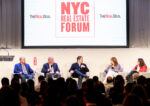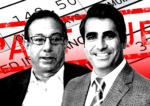Trending
The not-so-outer borough: Brooklyn’s fast-climbing home prices make it nearly as expensive as Manhattan

Manhattan estate brokers Ari Harkov and Warner Lewis recently started searching for apartments in the West Village on behalf of a client, who wanted to pay around $650,000 for a one-bedroom. Not satisfied by the inventory they found in that price range, they expanded the search to Brooklyn Heights, thinking that would yield much more space for the money.
They were wrong.
Brooklyn hasn’t offered up the massive discount their client was hoping for, said Lewis, who works out of the Halstead Property’s West Village office. These days, “it’s not a dramatic difference” in price between one-bedrooms in the West Village and comparable units in Brooklyn Heights, Lewis said. “I think you’re often looking at a 10 percent differential.”
In fact, the median asking price for a Brooklyn Heights apartment has risen 37.8 percent in the past five years to $792,500, according to data provided to The Real Deal by the real estate listings website StreetEasy. By contrast, the median price in the West Village rose by only 4.34 percent during that same period, to $895,000 (the chart on this page shows figures for the broader Greenwich Village area).
Manhattan or Brooklyn: The choice used to be an easy one. Those who could afford it chose “the city,” not the dowdy stepsister across the river, with its longer commutes and cheaper home prices. Today, though, Brooklyn is the top pick of more and more harried urbanites, and the proof is in the numbers. With sale prices and especially rents rising sharply in Brooklyn, brokers said, many home-seekers find that popular neighborhoods no longer come at the discount they’re expecting.
“When I get a call from a buyer looking for a place in Brooklyn and they say, ‘I want to move there because I want more space for my money,’ I don’t beat around the bush,” said Lindsay Barton Barrett, a broker from the Corcoran Group with listings in both boroughs. “I immediately tell them they’re going to be disappointed.”
This month, TRD analyzed market data to find out how real estate prices in prime Brooklyn neighborhoods compare to their Manhattan counterparts.
The data show that rents have been rising much faster in Brooklyn than in Manhattan, significantly narrowing the pricing gap between the two boroughs. In March, the median rental price for a one-bedroom apartment in prime Brooklyn neighborhoods was $2,560, an 11.3 percent jump from the same month of last year, according to a recent market report from the brokerage Prudential Douglas Elliman. By contrast, the median rental price for Manhattan was $3,195, an annual increase of 6.7 percent.
When it comes to sales, many Brooklyn neighborhoods are still cheaper than comparable areas of Manhattan, but the difference is smaller than it used to be. In the first quarter, the median sales price for a Brooklyn apartment shot up 14 percent to $515,000 year-over-year, Elliman’s data shows, while the median price in Manhattan rose just 5.9 percent to $820,555. And at least one popular Brooklyn neighborhood, Williamsburg, is now pricier than the comparable Manhattan neighborhood across the river: the Lower East Side. (The East Village is still more expensive than Williamsburg.)
There is one area where even prime Brooklyn neighborhoods represent a dramatic discount from Manhattan, however: the very high end of the sales market.
“Your money is going a lot further if you’re buying a townhouse or a very large apartment in Brooklyn,” said Barrett, who is handling sales at the new boutique condo 123 Fort Greene Place in Fort Greene, where prices start at $749,000 for a one-bedroom. “But if you’re looking for a two-bedroom apartment, the prices are much more similar.”
Casting a wide net
It’s no secret that Brooklyn home prices have been on the rise for years, as the borough’s idyllic brownstones increasingly lure artsy buyers out of Manhattan. And in the past few years, brokers told The Real Deal, they’ve seen more home-seekers looking simultaneously at Manhattan and Brooklyn, often considering neighborhoods with similar vibes. For instance, brokers said, a buyer looking for a loft might consider Dumbo and Tribeca, both known for their cobblestoned streets and converted warehouses; longtime Upper West Siders are drawn to Park Slope, with its preponderance of strollers and access to Prospect Park; and those looking for nightlife and a gritty feel often consider Williamsburg alongside the East Village and Lower East Side. And brokers said they’re now seeing a lot of overlap between Brooklyn Heights and the West Village, both pricey neighborhoods with historic brownstones and tree-lined streets.
“Now you’re finding that people are more open to both boroughs, not all of both boroughs but [certain neighborhoods],” said Terry Naini, a Town Residential broker with listings in both the West Village and Carroll Gardens. “It’s like those neighborhoods are an extension of the Manhattan market.”
And while Brooklyn has increased in popularity, some areas of Manhattan have yet to fully recover from the price drops they saw during the real estate downturn. Median prices in Murray Hill, for example, were $547,500 in the first quarter, down 45 percent from the same quarter five years ago, according to StreetEasy, while the median price in the South Street Seaport area is $680,000, down 54.7 percent from 2008 (those figures may be skewed by a few outlier high-end sales).
The city’s current inventory shortage — available Manhattan listings fell by 34 percent year-over-year in the first quarter — has accelerated the shrinking price gap between the two boroughs, as would-be Manhattan buyers widen their search to include Brooklyn, according to Jonathan Miller of Miller Samuel Real Estate Appraisers.
Meanwhile, Brooklyn maintenance and monthly charges have also been on the uptick as buildings there “catch up with the times,” Barrett said.
“There was a time when the average maintenance in Brooklyn — outside of BrooklynHeights — was probably about 50 percent of the average in Manhattan,” she said. “Now, if it is $1.50 in Manhattan, it’s probably $1 in Brooklyn.”
As a result of these changes, some sought-after Brooklyn neighborhoods are now almost as expensive as similar Manhattan areas.
Park Slope, for example, has long been viewed as essentially a cheaper version of the Upper West Side. Five years ago, according to StreetEasy, the median asking price of an apartment on the Upper West Side was $919,800, significantly more expensive than the $625,730 median in Park Slope.
That gap has now shrunk. The median sale price for an apartment in Park Slope was $675,000 in the first quarter, a 7.9 percent jump from the first quarter of 2008, StreetEasy’s data shows. During the same time period, the median price on the Upper West Side dropped by 2.5 percent to $897,000.
There’s even less of a price difference between the two neighborhoods when it comes to rentals. In Park Slope, renters now pay an annual average of $50 per square foot, compared to $59 on the Upper West Side, according to data provided to TRD by the brokerage MNS. The average monthly rent for a one-bedroom apartment in Park Slope in March was $2,319, MNS found, compared to $3,069 on the Upper West Side. That’s a narrower spread than in the same month of 2010, when Park Slope’s average was $1,899, compared to $2,733 on the Upper West Side.
Prices in Dumbo and Tribeca are also moving closer together, although Tribeca is still considerably more expensive.
In Dumbo, average rents have jumped 10 percent over the last three years to $67 per square foot per year, compared with $72 in Tribeca, according to MNS. The average monthly rent for a one-bedroom in Dumbo is $3,543, compared to $5,502 in Tribeca.
For sales, the average price per square foot for a Dumbo apartment in March was $1,261, compared to $1,702 per square foot in Tribeca, MNS found.
The overall median asking price for a Dumbo apartment in the first quarter was $959,000, according to StreetEasy, while the median price for Tribeca was $2.31 million.
Home-seekers looking at both Brooklyn Heights and the West Village will find that the median asking price for a Brooklyn Heights apartment in the first quarter was $792,500, a 37.8 percent jump from $575,000 five years ago, according to StreetEasy. By comparison, the average price of a West Village apartment grew by just 4.34 percent during that time, to $895,000.
Manhattanites may be able to find more of a discount in Williamsburg, which was hard hit by the real estate downturn; a slew of new condos opened in the neighborhood right around the time of Lehman Brothers’ collapse.
“The timing of all the waterfront towers going up sort of coincided with [the collapse of] Lehman,” Harkov said. Williamsburg, he added, “was the Miami of New York.”
The median asking price for an apartment in Williamsburg has actually declined by 2.2 percent to $585,493 over the past five years, StreetEasy data shows.
Still, the East Village has seen its median asking price drop 18.8 percent to $667,500 during the past five years, according to StreetEasy, putting it more in the range of Williamsburg prices.
All those new waterfront towers mean sale prices in Williamsburg are now even higher than on the Lower East Side. Over the past five years, prices on the Lower East Side fell 3.9 percent to $490,000, less than Williamsburg’s current median of $585,493. Rentals on the Lower East Side are still slightly more expensive than in Williamsburg, however. The average monthly rent for a one-bedroom apartment on the Lower East Side in March was $3,111, compared to $2,927 in Williamsburg.
Due in part to these higher prices, many Manhattanites are widening their search to Brooklyn neighborhoods they might not initially have considered.
“I used to see a direct correlation between the Upper East Side and Brooklyn Heights, and the Upper West Side and Park Slope,” Naini said. “I don’t find that so much anymore. I find Upper West Siders anywhere from Downtown Brooklyn to Carroll Gardens and Park Slope. They’re not focused on just one neighborhood.”
The high end
One area where there are still significant discounts in Brooklyn, data shows, is at the very high end of the market.
These days, “the price differential for a beautiful floor-through two-bedroom apartment in Brooklyn Heights versus the West Village is not particularly significant,” Barrett said. But the difference in cost “between townhouses in Brooklyn Heights and townhouses in the West Village is significant.”
For example, the holder of the record for Brooklyn’s most expensive single-family home sale is a Brooklyn Heights townhouse at 70 Willow Street where the writer Truman Capote once lived, which sold for $12 million last year. The most expensive Manhattan sale on record, by contrast, is the $88 million deal for a penthouse at 15 Central Park West, which closed in late 2011. And it’s rumored that an apartment at Extell Development’s One57 at 157 West 57th Street sold for upwards of $90 million, but the deal has not yet hit public records. Meanwhile, a unit at new development 432 Park went into contract for a reported $95 million, according to published reports late last month.
And the priciest townhouse ever sold in Manhattan was the Harkness Mansion on East 75th Street, which went for $53 million in 2006.
Current asking prices also show a significant gap between comparable townhouse properties between the two boroughs. A 2,300-square-foot carriage house at 21 Grace Court Alley in Brooklyn Heights, for example, is asking $3.5 million, while a 2,800-square-foot landmarked townhouse at 66 Charles Street in the West Village is listed with Elliman’s the De Niro Team for $8.5 million.
Miller said in the first quarter, buyers in the bottom 20 percent of the market paid approximately 30 percent more for Manhattan properties than for comparable properties in Brooklyn. By contrast, buyers in the top 20 percent of the market paid 58 percent more for Manhattan.
Barrett attributed the wider gap at the upper end of the market to an historic lack of demand for über-luxury properties in Brooklyn. Traditionally, buyers who could afford to drop several million dollars on a home preferred to remain in Manhattan, she said. And while moneyed buyers’ perceptions of Brooklyn are quickly changing, prices have yet to catch up.
“The move to Brooklyn started from the bottom,” Barnett said. “It was people who were priced out of Manhattan who were moving there. Those were the buyers of smaller apartments.
The buyers have now changed. Now there are tons of people looking for $5 million townhouses in Brooklyn.”




